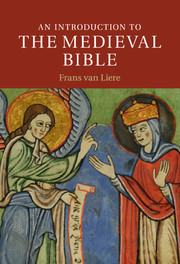Book contents
- Frontmatter
- Dedication
- Contents
- Preface
- Chapter 1 Introduction
- Chapter 2 The Bible as Book
- Chapter 3 The Medieval Canon
- Chapter 4 The Text of the Medieval Bible
- Chapter 5 Medieval Hermeneutics
- Chapter 6 The Commentary Tradition
- Chapter 7 The Vernacular Bible
- Chapter 8 The Bible in Worship and Preaching
- Chapter 9 The Bible of the Poor?
- Afterword
- Appendix A A Comparative Canon Chart
- Appendix B Names for Biblical Books
- Appendix C A Schematic Genealogy of Old Testament Translations
- Bibliography
- Index of Manuscripts Cited
- Index of Biblical References
- Subject and Author Index
- References
Chapter 9 - The Bible of the Poor?
Published online by Cambridge University Press: 05 June 2014
- Frontmatter
- Dedication
- Contents
- Preface
- Chapter 1 Introduction
- Chapter 2 The Bible as Book
- Chapter 3 The Medieval Canon
- Chapter 4 The Text of the Medieval Bible
- Chapter 5 Medieval Hermeneutics
- Chapter 6 The Commentary Tradition
- Chapter 7 The Vernacular Bible
- Chapter 8 The Bible in Worship and Preaching
- Chapter 9 The Bible of the Poor?
- Afterword
- Appendix A A Comparative Canon Chart
- Appendix B Names for Biblical Books
- Appendix C A Schematic Genealogy of Old Testament Translations
- Bibliography
- Index of Manuscripts Cited
- Index of Biblical References
- Subject and Author Index
- References
Summary
When Benedict Biscop traveled to Rome in the late seventh century (as told in the introduction to Bede's Lives of the Abbots; see Chapter 1), books were not all that he brought back for the fledgling church in Northumbria. Another necessity for the foundation of a vibrant Christian church in pagan northern England was “sacred images.” On his return from Rome, Bede tells us, Benedict
brought with him pictures of sacred images, to adorn the church of St. Peter, which he had built; namely, an image of the blessed mother of God and always Virgin Mary and of the twelve Apostles, with which he intended to adorn the central nave, on boards placed from one wall to the other; and also figures from ecclesiastical history to decorate the south wall of the church, and images from the Revelation of St. John similarly for the north wall; so that all who entered the church, even if they could not read, wherever they turned their eyes, might always contemplate the amiable countenance of Christ and His saints, even if only in image, and thus either, with more watchful minds, might be reminded of the benefits of our Lord's incarnation, or, having before their eyes the perils of the Last Judgement, might be reminded to examine themselves more strictly on that account.
Regrettably, none of these art works has survived, but Bede's story does remind us that art is an integral part of the story of the Bible in the Middle Ages. Depictions of biblical stories adorned houses of worship, as well as liturgical objects such as altars, Gospel books, and lectionaries. Alongside preaching, art and theatre (much like film and television today) allowed biblical content and Christian teaching to permeate the medieval mentality. This last chapter explores some of the contexts where art and the Bible intersected in the Middle Ages.
- Type
- Chapter
- Information
- An Introduction to the Medieval Bible , pp. 237 - 260Publisher: Cambridge University PressPrint publication year: 2014



